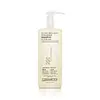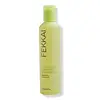What's inside
What's inside
 Key Ingredients
Key Ingredients

 Benefits
Benefits

 Concerns
Concerns

 Ingredients Side-by-side
Ingredients Side-by-side

Water
Skin ConditioningSodium Coco-Sulfate
CleansingCocamidopropyl Betaine
CleansingSodium Cocoamphoacetate
CleansingMelaleuca Alternifolia Leaf Oil
AntioxidantMentha Piperita Oil
MaskingRosmarinus Officinalis Leaf Extract
AntimicrobialMenthol
MaskingGlycerin
HumectantEucalyptus Globulus Leaf Oil
PerfumingLauryl Glucoside
CleansingLavandula Angustifolia Flower/Leaf/Stem Extract
MaskingSodium Cocoyl Glutamate
CleansingAloe Barbadensis Leaf Juice
Skin ConditioningSodium Lauryl Glucose Carboxylate
CleansingDecyl Glucoside
CleansingPolyquaternium-7
Polysorbate 20
EmulsifyingParfum
MaskingSalvia Officinalis Leaf Extract
CleansingPanthenol
Skin ConditioningCitric Acid
BufferingPhenoxyethanol
PreservativeEthylhexylglycerin
Skin ConditioningPotassium Sorbate
PreservativeChamomilla Recutita Flower Extract
MaskingThymus Vulgaris Extract
PerfumingWater, Sodium Coco-Sulfate, Cocamidopropyl Betaine, Sodium Cocoamphoacetate, Melaleuca Alternifolia Leaf Oil, Mentha Piperita Oil, Rosmarinus Officinalis Leaf Extract, Menthol, Glycerin, Eucalyptus Globulus Leaf Oil, Lauryl Glucoside, Lavandula Angustifolia Flower/Leaf/Stem Extract, Sodium Cocoyl Glutamate, Aloe Barbadensis Leaf Juice, Sodium Lauryl Glucose Carboxylate, Decyl Glucoside, Polyquaternium-7, Polysorbate 20, Parfum, Salvia Officinalis Leaf Extract, Panthenol, Citric Acid, Phenoxyethanol, Ethylhexylglycerin, Potassium Sorbate, Chamomilla Recutita Flower Extract, Thymus Vulgaris Extract
Water
Skin ConditioningSodium Cocoyl Isethionate
CleansingSodium Lauroyl Methyl Isethionate
CleansingLauryl Glucoside
CleansingHeptyl Glucoside
Disteareth-75 Ipdi
Coconut Acid
CleansingPunica Granatum Seed Oil Stearyl Esters
EmollientGlyceryl Oleate
EmollientPyrus Malus Fruit Extract
Skin ConditioningVinegar
Sorbitan Oleate
EmulsifyingSodium Isethionate
CleansingGlycerin
HumectantHydroxypropyl Guar Hydroxypropyltrimonium Chloride
Zingiber Officinale Root Extract
MaskingCaprylyl/Capryl Glucoside
CleansingMagnolia Officinalis Bark Extract
AntimicrobialPanthenol
Skin ConditioningXylitol
HumectantEpilobium Angustifolium Flower/Leaf/Stem Extract
Skin ConditioningPhaeodactylum Tricornutum Extract
HumectantPiper Nigrum Seed Extract
RefreshingLeptospermum Scoparium Branch/Leaf Oil
TonicSalvia Hispanica Seed Extract
EmollientCaesalpinia Spinosa Fruit Extract
Skin ProtectingLavandula Angustifolia Flower Extract
CleansingPelvetia Canaliculata Extract
Skin ProtectingLeontopodium Alpinum Extract
Skin ConditioningHydrolyzed Vegetable Protein
Skin ConditioningOryza Sativa Seed Protein
AntioxidantOryza Sativa Bran Extract
Skin ConditioningOryza Sativa Extract
AbsorbentHelianthus Annuus Sprout Extract
Skin ConditioningHelianthus Annuus Extract
EmollientRosmarinus Officinalis Leaf Extract
AntimicrobialSalicylic Acid
MaskingGalactaric Acid
Trehalose
HumectantArginine PCA
HumectantMaltodextrin
AbsorbentHydroxypropyl Methylcellulose Stearoxy Ether
Ethyl Oleate
EmollientPolyquaternium-37
Tocopherol
AntioxidantEthyl Linoleate
EmollientGluconolactone
Skin ConditioningCalcium Gluconate
HumectantOctyldodecanol
EmollientSodium Phosphate
BufferingEthylhexylglycerin
Skin ConditioningPotassium Sorbate
PreservativeSodium Benzoate
MaskingChlorphenesin
AntimicrobialBenzyl Alcohol
PerfumingAlcohol
AntimicrobialPhenoxyethanol
PreservativeCaprylyl Glycol
EmollientCaprylic Acid
CleansingParfum
MaskingPhytic Acid
Sodium Phytate
Trisodium Ethylenediamine Disuccinate
Sodium Metabisulfite
AntioxidantPentaerythrityl Tetra-Di-T-Butyl Hydroxyhydrocinnamate
AntioxidantTbhq
AntioxidantLimonene
PerfumingGeraniol
PerfumingLinalool
PerfumingCitronellol
PerfumingCitral
PerfumingEugenol
PerfumingHexyl Cinnamal
PerfumingAmyl Cinnamal
PerfumingCitric Acid
BufferingPotassium Hydroxide
BufferingWater, Sodium Cocoyl Isethionate, Sodium Lauroyl Methyl Isethionate, Lauryl Glucoside, Heptyl Glucoside, Disteareth-75 Ipdi, Coconut Acid, Punica Granatum Seed Oil Stearyl Esters, Glyceryl Oleate, Pyrus Malus Fruit Extract, Vinegar, Sorbitan Oleate, Sodium Isethionate, Glycerin, Hydroxypropyl Guar Hydroxypropyltrimonium Chloride, Zingiber Officinale Root Extract, Caprylyl/Capryl Glucoside, Magnolia Officinalis Bark Extract, Panthenol, Xylitol, Epilobium Angustifolium Flower/Leaf/Stem Extract, Phaeodactylum Tricornutum Extract, Piper Nigrum Seed Extract, Leptospermum Scoparium Branch/Leaf Oil, Salvia Hispanica Seed Extract, Caesalpinia Spinosa Fruit Extract, Lavandula Angustifolia Flower Extract, Pelvetia Canaliculata Extract, Leontopodium Alpinum Extract, Hydrolyzed Vegetable Protein, Oryza Sativa Seed Protein, Oryza Sativa Bran Extract, Oryza Sativa Extract, Helianthus Annuus Sprout Extract, Helianthus Annuus Extract, Rosmarinus Officinalis Leaf Extract, Salicylic Acid, Galactaric Acid, Trehalose, Arginine PCA, Maltodextrin, Hydroxypropyl Methylcellulose Stearoxy Ether, Ethyl Oleate, Polyquaternium-37, Tocopherol, Ethyl Linoleate, Gluconolactone, Calcium Gluconate, Octyldodecanol, Sodium Phosphate, Ethylhexylglycerin, Potassium Sorbate, Sodium Benzoate, Chlorphenesin, Benzyl Alcohol, Alcohol, Phenoxyethanol, Caprylyl Glycol, Caprylic Acid, Parfum, Phytic Acid, Sodium Phytate, Trisodium Ethylenediamine Disuccinate, Sodium Metabisulfite, Pentaerythrityl Tetra-Di-T-Butyl Hydroxyhydrocinnamate, Tbhq, Limonene, Geraniol, Linalool, Citronellol, Citral, Eugenol, Hexyl Cinnamal, Amyl Cinnamal, Citric Acid, Potassium Hydroxide
Ingredients Explained
These ingredients are found in both products.
Ingredients higher up in an ingredient list are typically present in a larger amount.
Citric Acid is an alpha hydroxy acid (AHA) naturally found in citrus fruits like oranges, lemons, and limes.
Like other AHAs, citric acid can exfoliate skin by breaking down the bonds that hold dead skin cells together. This helps reveal smoother and brighter skin underneath.
However, this exfoliating effect only happens at high concentrations (20%) which can be hard to find in cosmetic products.
Due to this, citric acid is usually included in small amounts as a pH adjuster. This helps keep products slightly more acidic and compatible with skin's natural pH.
In skincare formulas, citric acid can:
While it can provide some skin benefits, research shows lactic acid and glycolic acid are generally more effective and less irritating exfoliants.
Most citric acid used in skincare today is made by fermenting sugars (usually from molasses). This synthetic version is identical to the natural citrus form but easier to stabilize and use in formulations.
Read more about some other popular AHA's here:
Learn more about Citric AcidEthylhexylglycerin (we can't pronounce this either) is commonly used as a preservative and skin softener. It is derived from glyceryl.
You might see Ethylhexylglycerin often paired with other preservatives such as phenoxyethanol. Ethylhexylglycerin has been found to increase the effectiveness of these other preservatives.
Glycerin is already naturally found in your skin. It helps moisturize and protect your skin.
A study from 2016 found glycerin to be more effective as a humectant than AHAs and hyaluronic acid.
As a humectant, it helps the skin stay hydrated by pulling moisture to your skin. The low molecular weight of glycerin allows it to pull moisture into the deeper layers of your skin.
Hydrated skin improves your skin barrier; Your skin barrier helps protect against irritants and bacteria.
Glycerin has also been found to have antimicrobial and antiviral properties. Due to these properties, glycerin is often used in wound and burn treatments.
In cosmetics, glycerin is usually derived from plants such as soybean or palm. However, it can also be sourced from animals, such as tallow or animal fat.
This ingredient is organic, colorless, odorless, and non-toxic.
Glycerin is the name for this ingredient in American English. British English uses Glycerol/Glycerine.
Learn more about GlycerinLauryl Glucoside sugar- and lipid-based cleansing agent. It is created from glucose and lauryl alcohol.
This ingredient is a surfactant, making it easier to rinse oil, dirt, and other pollutants away.
A British study found lauryl glucoside to cause skin sensitivity for some people. We recommend speaking with a professional if you have concerns.
Other names for this ingredient include "Lauryl Polyglucose", "Lauryl glycoside", and "D-Glucopyranoside".
Learn more about Lauryl GlucosidePanthenol is a common ingredient that helps hydrate and soothe the skin. It is found naturally in our skin and hair.
There are two forms of panthenol: D and L.
D-panthenol is also known as dexpanthenol. Most cosmetics use dexpanthenol or a mixture of D and L-panthenol.
Panthenol is famous due to its ability to go deeper into the skin's layers. Using this ingredient has numerous pros (and no cons):
Like hyaluronic acid, panthenol is a humectant. Humectants are able to bind and hold large amounts of water to keep skin hydrated.
This ingredient works well for wound healing. It works by increasing tissue in the wound and helps close open wounds.
Once oxidized, panthenol converts to pantothenic acid. Panthothenic acid is found in all living cells.
This ingredient is also referred to as pro-vitamin B5.
Learn more about PanthenolParfum is a catch-all term for an ingredient or more that is used to give a scent to products.
Also called "fragrance", this ingredient can be a blend of hundreds of chemicals or plant oils. This means every product with "fragrance" or "parfum" in the ingredients list is a different mixture.
For instance, Habanolide is a proprietary trade name for a specific aroma chemical. When used as a fragrance ingredient in cosmetics, most aroma chemicals fall under the broad labeling category of “FRAGRANCE” or “PARFUM” according to EU and US regulations.
The term 'parfum' or 'fragrance' is not regulated in many countries. In many cases, it is up to the brand to define this term.
For instance, many brands choose to label themselves as "fragrance-free" because they are not using synthetic fragrances. However, their products may still contain ingredients such as essential oils that are considered a fragrance by INCI standards.
One example is Calendula flower extract. Calendula is an essential oil that still imparts a scent or 'fragrance'.
Depending on the blend, the ingredients in the mixture can cause allergies and sensitivities on the skin. Some ingredients that are known EU allergens include linalool and citronellol.
Parfum can also be used to mask or cover an unpleasant scent.
The bottom line is: not all fragrances/parfum/ingredients are created equally. If you are worried about fragrances, we recommend taking a closer look at an ingredient. And of course, we always recommend speaking with a professional.
Learn more about ParfumPhenoxyethanol is a preservative that has germicide, antimicrobial, and aromatic properties. Studies show that phenoxyethanol can prevent microbial growth. By itself, it has a scent that is similar to that of a rose.
It's often used in formulations along with Caprylyl Glycol to preserve the shelf life of products.
Potassium Sorbate is a preservative used to prevent yeast and mold in products. It is commonly found in both cosmetic and food products.
This ingredient comes from potassium salt derived from sorbic acid. Sorbic acid is a natural antibiotic and effective against fungus.
Both potassium sorbate and sorbic acid can be found in baked goods, cheeses, dried meats, dried fruit, ice cream, pickles, wine, yogurt, and more.
You'll often find this ingredient used with other preservatives.
Learn more about Potassium SorbateRosmarinus Officinalis Leaf Extract comes from rosemary. Rosemary is native to the Mediterranean.
While Rosmarinus Officinalis Leaf Oil can be volatile due to its fragrant properties, the fragrance components are usually removed in the leaf extract.
Rosemary Leaf Extract contains many antioxidants such as rosmarinic acid and caffeic acid. Rosemarinic acid, a compound found in rosemary leaf, has been found to help soothe skin conditions such as eczema and acne.
Learn more about Rosmarinus Officinalis Leaf ExtractWater. It's the most common cosmetic ingredient of all. You'll usually see it at the top of ingredient lists, meaning that it makes up the largest part of the product.
So why is it so popular? Water most often acts as a solvent - this means that it helps dissolve other ingredients into the formulation.
You'll also recognize water as that liquid we all need to stay alive. If you see this, drink a glass of water. Stay hydrated!
Learn more about Water